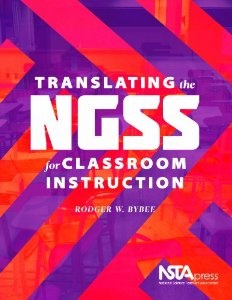Translating the NGSS for Classroom Instruction
By Carole Hayward
Posted on 2013-11-18
 Rodger Bybee’s new book Translating the NGSS for Classroom Instruction gives science teachers a powerful tool for moving the new science standards into classroom practices. Having the NGSS is a critical piece, but they will only go so far in affecting true reform if the standards aren’t applied to how science education is delivered in the classroom.
Rodger Bybee’s new book Translating the NGSS for Classroom Instruction gives science teachers a powerful tool for moving the new science standards into classroom practices. Having the NGSS is a critical piece, but they will only go so far in affecting true reform if the standards aren’t applied to how science education is delivered in the classroom.
In Translating the NGSS for Classroom Instruction, Bybee tackles the questions and concerns that teachers have:
- How will the NGSS affect my teaching?
- How do I translate the standards to classroom instruction?
- Are there instructional materials that align with the standards?
- How does my teaching (at the elementary, middle, or high school level) fit into the K-12 science curriculum?
- Will national, state, district, and classroom assessments change?
- How can the standards in the NGSS be used to create school programs and curriculum materials for classroom instruction?
The NGSS provide a powerful set of policies to guide the improvement of science education. As important and challenging as the development of the NGSS is, the standards represent only one step in the progress of standards-based improvement of science education. The NGSS specifically include features that address issues associated with implementation.
The NGSS are based on the following foundational ideas:
- Present performance expectations for all students.
- Describe policies and not a curriculum.
- Clarify equity and excellence.
- Integrate engineering with science.
- Provide guidance for college and career readiness.
As Bybee explains, “The task of translating the Framework to NGSS and NGSS to school curriculum and classroom instruction has some characteristics in common with the process of translating a book from one language to another…. In the process of translating standards to curriculum (i.e., programs) and instruction (i.e., practices), one must endeavor to understand standards as policies and the requirements of school programs and classroom practices.”
Translating Performance Expectations to Classroom Instruction
A useful perspective is to approach the translation as a sequence of lessons, not a lesson of each performance expectation. Understanding of the practices, ideas, and concepts should be developed using multiple lessons in a carefully designed sequence.
For students to meet the requirements described in the beginning, middle, and conclusion of the instructional sequence:
- What did the teacher do?
- What did the students do?
- How would you determine if the students can demonstrate the understandings described in the performance expectations?
- How would you assess student learning?
- What would you design as an assessment that provides acceptable evidence that students have learned the science and engineering practices, disciplinary core ideas, and crosscutting concepts in the performance expectations?
- Describe how you would assess the performance expectations.
- Describe the challenges you encountered in translating the standard
- Were these challenges of vocabulary? Science content? Architecture of the standard? Other?
- What was lost and gained in the translation?
Bybee goes on to assert that what counts as student improvement is student achievement. He explains that higher student achievement can be attained by focusing on the instructional core.
He outlines his plan for each chapter of the book
- Answers questions about translating standards to classroom practices
- Gives insights about reforming curriculum for schools, districts, and states
- Provides examples of curriculum, instruction, and assessment
Bybee emphasizes the need for clear and coherent curriculum and instruction that connect standards and assessments. “If there is no curriculum for teachers, I predict the standards will be implemented with far less integrity than intended by the NRC Framework and those who developed the NGSS.”
Check out the sample chapter: From NGSS to Classroom Instruction
This books is also available as an e-book.
Disclaimer: The views expressed in this blog post are those of the author(s) and do not necessarily reflect the official position of the National Science Teaching Association (NSTA).


